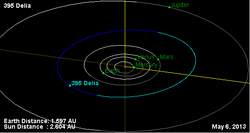Astronomy:395 Delia
From HandWiki
Short description: Main-belt asteroid
 Orbital diagram | |
| Discovery | |
|---|---|
| Discovered by | Auguste Charlois |
| Discovery date | 30 November 1894 |
| Designations | |
| (395) Delia | |
| Pronunciation | /ˈdiːliə/[1] |
| Named after | Artemis Delia |
| 1894 BK | |
| Minor planet category | Main belt |
| Orbital characteristics[2] | |
| Epoch January 21, 2022 (JD 2459600.5) | |
| Uncertainty parameter 0 | |
| Observation arc | 89.57 yr (32,714 d) |
| |{{{apsis}}}|helion}} | 3.021 astronomical unit|AU (451.9 Gm) |
| |{{{apsis}}}|helion}} | 2.550 AU (381.5 Gm) |
| 2.785 AU (416.6 Gm) | |
| Eccentricity | 0.085 |
| Orbital period | 4.64 yr (1,696.3 d) |
| Mean anomaly | 277.5° |
| Mean motion | 0° 12m 43.2s / day |
| Inclination | 3.35° |
| Longitude of ascending node | 259.3° |
| 11.1° | |
| Physical characteristics | |
| Dimensions | 44.2±0.5 km |
| Rotation period | 19.681 h (0.82 d)[3] |
| Geometric albedo | 0.033±0.004 |
| C (Tholen) | |
| Absolute magnitude (H) | 10.38 |
Delia (minor planet designation: 395 Delia) is a large Main belt asteroid. It was discovered by the French astronomer Auguste Charlois on 30 November 1894 in Nice. "Delia" is an epithet for the ancient Greco-Roman Moon goddess Artemis, for her birthplace at Delos.[4] This asteroid is orbiting the Sun at a distance of 2.79 astronomical unit|AU with an orbital eccentricity (ovalness) of 0.085 and a period of 4.64 yr. The orbital plane is tilted at an angle of 3.35° to the plane of the ecliptic.[2]
This is a dark, carbonaceous body with a low albedo of 0.03 and is classified as a C-type asteroid in the Tholen taxonomy. It has an estimated cross-section of 44.2[2] km/s and is spinning with a rotation period of 19.7 hours.[3]
References
- ↑ Delian (3rd ed.), Oxford University Press, September 2005, http://oed.com/search?searchType=dictionary&q=Delian (Subscription or UK public library membership required.)
- ↑ 2.0 2.1 2.2 "395 Delia (1894 BK)". JPL Small-Body Database. NASA/Jet Propulsion Laboratory. https://ssd.jpl.nasa.gov/sbdb.cgi?sstr=395;cad=1.
- ↑ 3.0 3.1 Pilcher, Frederick (January 2020). "Lightcurves and Rotation Periods of 33 Polyhymnia, 206 Hersilia, 395 Delia, 400 Ducrosa, 900 Rosalinde, and 1066 Lobelia". Bulletin of the Minor Planets Section of the Association of Lunar and Planetary Observers 47 (1): 34–36. Bibcode: 2020MPBu...47...34P.
- ↑ Schmadel, Lutz D. (2013). Dictionary of Minor Planet Names. Springer Berlin Heidelberg. p. 72. ISBN 9783662066157. https://books.google.com/books?id=eHv1CAAAQBAJ&pg=PA72.
External links
- 395 Delia at AstDyS-2, Asteroids—Dynamic Site
- 395 Delia at the JPL Small-Body Database
 |

